| These highlights chronicle the year 2018. Created
incrementally as new photos were available, the year runs generally
"backwards" on this page. Unlike earlier years, many highlights have been limited to the exceptional rarities. The abbreviation "MTY" means "Monterey County"
in the text below. Text by Don Roberson. Photos on this page
are copyrighted by the photographers to whom they are
attributed, and may not be reproduced in any form (including
other web sites) without the express consent of the photographer. |
| |
| Two final amazing birds concluded 2018. First, the Yellow-breasted Chat
that wintered at Laguna Grande Park in Seaside the last two years
returned on 12 Oct (Kent Johnson) and was still present through the end
of the year, seeking to survive an unprecedented third winter in
northern California (photo below 13 Dec © Blake T. Matheson).
Second, a totally unexpected Sage Thrasher turned up eating toyon berries and sitting atop a wall at the In-n-Out Burger
parking lot adjoining Laguna Grande Park on 9 Dec by David Yee. It,
too, remained into the New Year, somehow surviving the drive-in traffic
(photo below right 9 Dec © Bill Hill). Laguna Grande also hosted
other wintering rarities to year's end, including two Nashville
Warblers, a Swamp Sparrow, and single Yellow, Palm, Black-and-white,
and Tennessee Warblers! |
|

Since
the last update of this page in mid-November, three more rare boobies
were present locally during our most amazing booby year ever. On 29
Nov, Karl Bardon saw an adult Nazca Booby fly past Pt. Pinos as part of the Pt. Pinos seawatch. The next day, 30 Nov, Bardon and Brian Sullivan documented an adult Masked Booby flying past the Point (photo below © Brian L. Sullivan).
Also
on 30 Nov, the Monterey harbor-master was given a sick booby (we don't
know exactly when or where the booby was captured, but presumably in
the Monterey harbor area). Our local SPCA was called and they retrieved
this dark-morph Red-footed Booby (photo right 3 Dec
© Ciera Duits-Cavanaugh for Monterey SPCA). It was initially
thought that the booby would not last through the night, but it did and
started to improve. On 13 Dec, SPCA transferred this booby to
International Bird Rescue in the S.F. Bay Area, with hopes that it
would fully recover and possibly be eventually released in Hawaii. |
|
| |
A NEW NON-NATIVE BIRD ARRIVING?
The
spread of non-native birds is always problematic — at what point does a
non-native species become "established" and thus become a "permanent"
part of the local avifauna? From a State level, that is determined by
the California Bird Records Committee (CBRC) based on their bylaws,
which provide:
The
Committee will also review records of breeding populations of
introduced species not on the state list, but only if evidence is
submitted that attempts to prove (a) the correct identification of the
species and (b) the viability of the population. To be judged viable, a population must: (i) have bred in the state for fifteen (15) consecutive years, (ii) in general, be increasing or stabilized
after an initial period of increase, (iii) be judged to have occupied
all geographically contiguous suitable habitat to such a degree as to
sustain the population and be thought unlikely to significantly diminish,
and (iv) occupy an environment judged similar enough in ecological
factors (e.g., climate, vegetation, food, shelter, competitors,
predators) to the species’ natural habitat, or to other successful
introductions, that permanent establishment seems likely.
The history of non-native introductions has shown four basic chronologies:
- Escaped
or released birds do not survive long (for example, many tropical
species don't survive our winters) but those that are common in the pet
trade do escape or are released, and are seen "in the wild": examples
include various flamingos, non-migratory waterfowl, macaws, Budgerigar,
Zebra Finch, and many more.
- Escaped or
released birds mostly don't survive long, except in a small area, where
they breed and survive for years, but they never spread far from that
small area: examples included Northern Cardinal in the Los Angeles area
or Rose-ringed Parakeet in Bakersfield. On a national level these have
included Blue-gray Tanager in Florida, Black Francolin in Louisiana,
and Crested Myna in Vancouver, B.C. vicinity. Despite breeding for
years, all these local populations eventually failed. The same applied
to Red-crowned Parrot in MTY, which bred sporadically on the Monterey
Peninsula from about 1983-2003, and got up to 13 birds, but all are
gone now.
- A more broadscale boom and then a
bust with the entire population eventually disappearing. Spotted Dove
in California was very common and widespread for decades, but now has
declined to tiny remnants; they may be out-competed by Eurasian
Collard-Dove. European Goldfinch in the northeastern U.S. had that
trajectory — so common in the 1950-1960s that they were in the standard
field guide, but no breeding population exists now.
- A
broadscale boom and expansion, often reaching a widespread peak (and
sometimes a decline to a "stability" point, and becoming permanently
established. Under the State bylaws, the CBRC has accepted 11
non-native species as meeting the criteria and thus "permanent
establishment seems likely": Wild Turkey, Ring-necked Pheasant, Chukar,
White-tailed Ptarmigan, Rock Pigeon, Spotted Dove, Eurasian
Collared-Dove, Red-crowned Parrot, European Starling, House Sparrow,
and Scaly-breasted Munia. Obviously, each of these species are
"established" within their appropriate habitat — the Ptarmigan are only
at high elevations above treeline in the Sierra Nevada; the Chukar is
confined to very arid, rocky habitat in the interior; the Red-crowned
Parrot and Scaly-breasted Munia are primarily in coastal southern
California.
It is often
impossible to determine which pathway a particular introduction of a
non-native bird will take without years of data. In Monterey County
only five species are currently considered permanent residents. All are
widespread throughout the county: Turkey, Rock Pigeon, Collared-Dove,
Starling, and House Sparrow. The most recent of these is Eurasian
Collared-Dove. A small colony in King City in 1999-2000 was traced to
releases from a local aviary. The first on the Monterey Peninsula was
in March 2000 and the first pair was seen in 2002. More and more
appeared each year and pairs were breeding. A large increase from
2005-2007 spread doves widely. Today they are common in populated areas
throughout MTY. It took at least 5 years from the first one in Carmel
in 2000 to determine that Eurasian Collared-Dove was a part of the MTY
avifauna. [For birders using standard listing rules, non-natives are
not "countable" until determined to be "established."]
We
may now be in the early stages of the possible establishment of
Scaly-breasted Munia in MTY. There are the CBRC-accepted populations in
southern California from San Luis Obispo County to San Diego County
(estimated at 1,400 birds in 2011) that continue to grow and spread. To
the north, Santa Clara County has had escapees since 1997, nesting
since about 2000, and more recently a potential population growing at
specific sites (more details on Kendric Smith's web site). Recent reports at Pinto Lake in Santa Cruz County might suggest a spread southwards from the Santa Clara population.
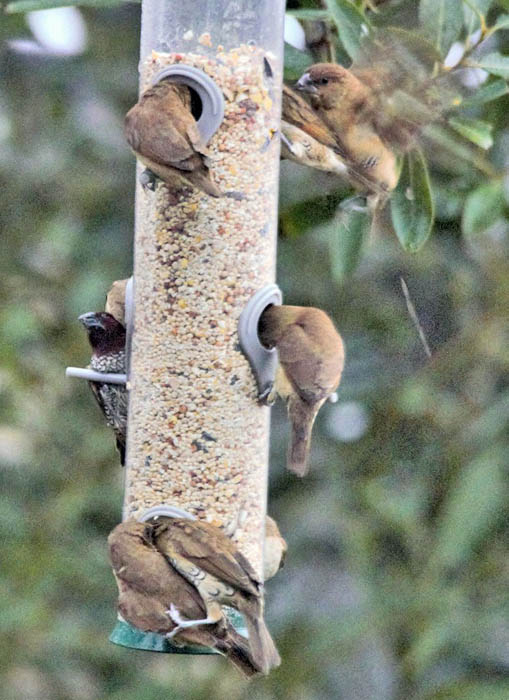 The
first 3 records from MTY were reported Nov 2017-Jan 2018 but then there
were none for months; it seems apparent that these first released or
escaped birds did not survive. This fall, however, there are 4 records
around the Peninsula involving multiple birds in small flocks of up to
6-8 individuals. Laguna Grande Park and the Frog Pond Preserve had
small flocks in reedbeds. These might be birds from an expanding
population elsewhere in the State, but these sites are also the most
logical spots for people to release non-natives. Non-native turtles and
fish are known commonly from Laguna Grande and Roberts Lake; I
personally talked to someone releasing their large pet goldfish because
they had to move and felt these ponds would be places their pet might
survive. Munias breed easily in captivity, and often breed in our
autumn, so it is a logical time for pet-owners to release the whole
family. So far, none of these groups has been seen in any week
following a report, which might suggest the birds are not surviving. We
just don't know the true facts, and don't have enough data to determine
their status. The
first 3 records from MTY were reported Nov 2017-Jan 2018 but then there
were none for months; it seems apparent that these first released or
escaped birds did not survive. This fall, however, there are 4 records
around the Peninsula involving multiple birds in small flocks of up to
6-8 individuals. Laguna Grande Park and the Frog Pond Preserve had
small flocks in reedbeds. These might be birds from an expanding
population elsewhere in the State, but these sites are also the most
logical spots for people to release non-natives. Non-native turtles and
fish are known commonly from Laguna Grande and Roberts Lake; I
personally talked to someone releasing their large pet goldfish because
they had to move and felt these ponds would be places their pet might
survive. Munias breed easily in captivity, and often breed in our
autumn, so it is a logical time for pet-owners to release the whole
family. So far, none of these groups has been seen in any week
following a report, which might suggest the birds are not surviving. We
just don't know the true facts, and don't have enough data to determine
their status.
However, the presence of up to 15
individuals in small flocks at a feeder near Salmon Creek, just 2 miles
north of the Monterey-San Luis Obispo border does suggest that it may
represent an incursion into MTY of "established population" birds from
the Morro Bay area. The location is less than 20 miles from "known"
populations. Dan Richards documented these on 9, 21, and 22 Nov 2018
(photo right © Dan Richards, shows 9 munias at his feeder). These
were not present every day but it does show that these munias were
surviving for several weeks.
Because the Salmon
Creek vicinity munias seem likely to have originated from "established"
populations in SLO, they might be the first of a larger incursion from
the south into MTY. It is possible that Monterey Peninsula birds are
local releases or escapees, or perhaps longer-distance incursions from
farther away, or a mix of both. To permit anyone to trace these
movements, we are now approving these records in eBird. It will take a
longer time to determine when and if a population of munias become
established in MTY. They may happen . . . or it could be that they
won't take hold here locally. Only time will tell. |
|
| |
|
More tropical boobies!
The highlight pages for summer 2018 were filled with news of tropical
seabirds, particularly boobies. Nazca and Red-footed were the key
species then. Now, in autumn 2018, another Red-footed Booby and a
Masked Booby are front-page news. The Red-footed Booby
is a feisty subadult in Santa Cruz County, using a regular roosting
location at the tip of Seacliff SB pier (above, contesting the
preferred roosting spot with a dominate Brown Pelican (photo above 8
Nov © Don Roberson). Quite possibly the same individual as seen
from a Monterey Bay pelagic trip in the SCZ portion of the Bay on 21
Oct, it was first reported at the Seacliff pier on 1 Nov by Laura
Paulson. It leaves to forage out to sea daily, possibly among a pod of
Humpbacks often seen at a distance. See the summer highlights for more details of Red-footed Booby in MTY and northern California.
The other unexpected autumn booby was a near-adult Masked Booby
roosting at the tip of Pt. Pinos off-and-on during 17-19 Oct. Found
near dusk on 17 Oct by Blake Matheson, it also left daily to forage out
to sea, and then returned for a nightly roosting spot over the
succeeding two days. Comparison of photos taken on a pelagic trip in
the SCZ portion of Monterey Bay on 13 Oct showed it to be that same
individual, so it moved nearly 20 miles in choosing this roost (photos
below taken at different times on 18 Oct, below left © David Tomb;
photo below right © Fred Hochstaedter). The all-yellow bill and
all-black tail are key features separating adult or near-adult Masked
Booby from Nazca Booby (see Roberson 1998 and other seabird texts).
This was just the second MTY record of Masked Booby. The first was an
adult that roosting on a sandspit at the Salinas River mouth on 18, 20,
and 22 June 1992, and was photographed. [A potential additional record,
cited in Roberson 2002, is not documented by photos, and is not CBRC
accepted.] |
|
 The
return of the Masked Booby to its roost on 18 Oct coincided with "day
1" of the 4th annual 2018 Monterey Audubon "Pt. Pinos seawatch,
"featuring the return of Karl Bardon (from MN) for his second year as
the professional seawatcher. Here Karl, near left, scopes the booby
next to (L to R) Fred Hochstaedter, Mark Kudrav, Todd Wills, and
Michael Rieser (photo © D. Roberson). This year's seawatch runs
from 18 Oct–15 Dec, which is two weeks longer than the preceding three
efforts over the period 1 Nov-15 Dec. The
return of the Masked Booby to its roost on 18 Oct coincided with "day
1" of the 4th annual 2018 Monterey Audubon "Pt. Pinos seawatch,
"featuring the return of Karl Bardon (from MN) for his second year as
the professional seawatcher. Here Karl, near left, scopes the booby
next to (L to R) Fred Hochstaedter, Mark Kudrav, Todd Wills, and
Michael Rieser (photo © D. Roberson). This year's seawatch runs
from 18 Oct–15 Dec, which is two weeks longer than the preceding three
efforts over the period 1 Nov-15 Dec. |
| |
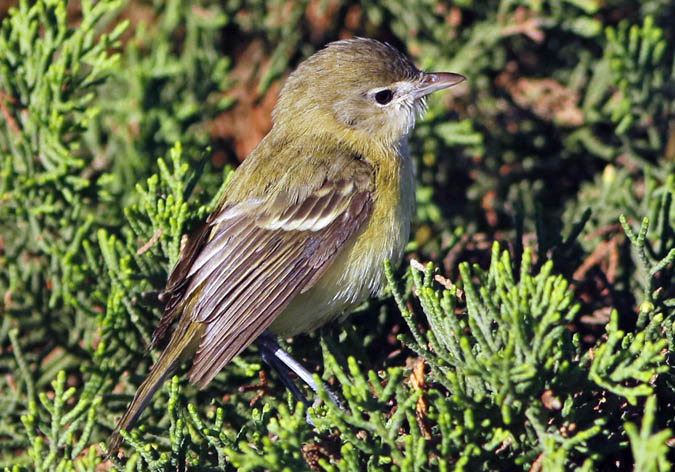 Incredible eastern vagrants!
The fall of 2018 also sparkled as orchestrating one of the most
dazzling displays of colorful eastern North American vagrants in recent
history, particularly vireos and warblers. Probably the most unexpected
was the least pretentious: this Bell's Vireo, from one of the eastern populations (i.e., subspecies bellii or medius),
at Pt. Pinos from 14-17 Oct (photo right 16 Oct © D. Roberson).
Found by visiting bird John Mendoza of San Luis Obispo County, the very
active small passerine focused on coastal dune scrub and an occasional
adjacent cypresses during it stay, often at off-limits areas of the
Pacific Grove golf course at the Point. Incredible eastern vagrants!
The fall of 2018 also sparkled as orchestrating one of the most
dazzling displays of colorful eastern North American vagrants in recent
history, particularly vireos and warblers. Probably the most unexpected
was the least pretentious: this Bell's Vireo, from one of the eastern populations (i.e., subspecies bellii or medius),
at Pt. Pinos from 14-17 Oct (photo right 16 Oct © D. Roberson).
Found by visiting bird John Mendoza of San Luis Obispo County, the very
active small passerine focused on coastal dune scrub and an occasional
adjacent cypresses during it stay, often at off-limits areas of the
Pacific Grove golf course at the Point.
California is host to the pusillus
subspecies of Bell's Vireo, a very gray bird often known as "Least
Bell's Vireo," which is an endangered species. It used to breed in
southern MTY but the last recorded breeding evidence on the Salinas
River near Bradley was back in 1993. The subspecies arizonae — gray
with yellowish flanks — is common in Arizona and breeds sparsely on the
California side of the Colorado River. But "eastern Bell's Vireo" is
strictly a very rare vagrants in California.
From
what I can glean from eBird and selected literature, there are only
about a dozen prior records of "eastern Bell's Vireo" in all of
California. Most (8-9) are from fall migration (Sep-Nov), one spring
vagrant at Pt. Reyes, and three rather recent wintering individuals in
southern California. Vagrants have reached San Clemente I. and the
Farallones, but only San Diego Co. has multiple records (about four).
This Pt. Pinos bird is a first for MTY.
|
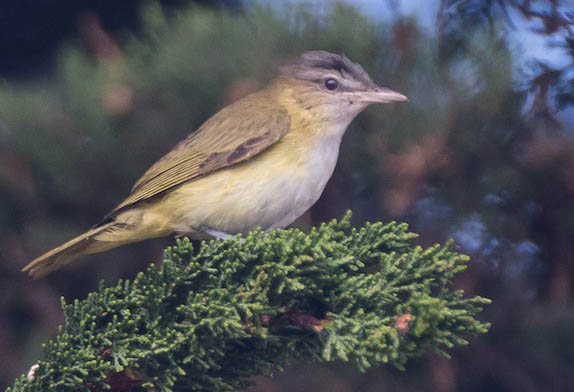 On 11-12 Oct there was a hatch-year Yellow-green Vireo
at Laguna Grande Park, found by Paul Fenwick. Note the dark eye and
crisp plumage (photo left © Blake T. Matheson). A red-eyed adult
was in Pacific Grove earlier this fall; see photo on prior highlight page. On 11-12 Oct there was a hatch-year Yellow-green Vireo
at Laguna Grande Park, found by Paul Fenwick. Note the dark eye and
crisp plumage (photo left © Blake T. Matheson). A red-eyed adult
was in Pacific Grove earlier this fall; see photo on prior highlight page.
Philadelphia Vireo (below) is a very rare eastern vagrant in MTY. There were previously 13 records, including two last fall (fall 2017 highlights). Almost unbelievably, there were seven "Philly" Vireos this fall:
• 6 Sep at Laguna Grande (B.L. Sullivan)
• 14-19 Sep at Frog Pond (Hugo Ceja, Rita Carratello)
• 29 Sep
in Pacific Grove (D. Roberson)
• 30 Sep at Carmel R. mouth (Michael Rieser)
• 2 Oct at Big Sur R. mouth (Michael Rieser)
• 12-14 Oct nr Carmel Highlands (M. Rieser)
• 20 Oct at Carmel R. mouth (Hugo Ceja)
This brings MTY's total to 20. Note that Michael Rieser found 3 of these, Hugo Ceja was involved in finding two.
|
Of the seven Philadelphia Vireos,
a remarkable five were photographed. Here's a couple of those shots: 2
Oct at Big Sur R. mouth (near right © Michael Rieser) and 20 Oct
at Carmel River mouth (far right © Hugo Ceja). |
|
|
To round out the rare vireos for 2018, the first 'chaseable' Blue-headed Vireo
since the formal split of the "Solitary Vireos" in 1998 was at the
Carmel River mouth this fall. It was photographed by Michael Rieser on
30 Sep but left uncertain until found and photographed again on 8 Oct
(photo right © Carole Rose). It was generally elusive in the
canopy through 11 Oct. Note the dark blue-gray face, the very crisp
demarcation between head color and the white throat, and the very
extensive yellow on the sides of breast and down through flanks and
vent. There were at least 12 records prior to this bird, most of them
before the formal split, and most from fall migration. |
|
|
|
| Before turning to eastern
warblers, let's mention a late October vagrant gull. Rare gulls
generally turn up in winter but on 28 Oct a near-adult Lesser Black-backed Gull
was discovered at the Carmel River lagoon by Brian Browne while
participating in a weekend field trip to the Monterey area by members
of the California Young Birders Club. Fred Hochstaedter and Catherine
Webb just happened to be nearby, scoping for Harlequin Duck at the
time, and Catherine obtain this flight shot (photo below © C.
Webb). This gull has an all-white tail, suggesting it is at least 4
years old, but is still in primary molt and still has a messy bill
pattern, suggesting it is perhaps just turning four-years-old. We might
call it an adult or near-adult — the bright yellow eye is an important
character in this species. This is just the 5th record for MTY. |
|
|
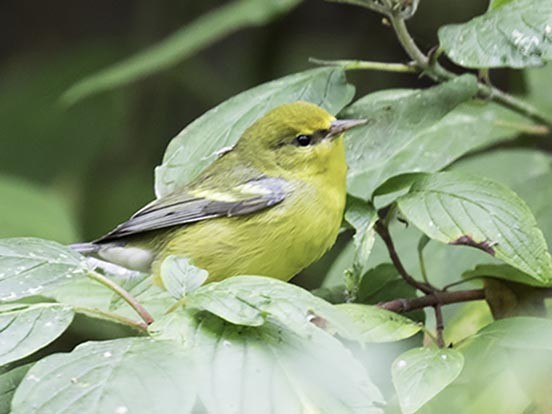 Eastern
warblers made so many appearances in Sep–Oct that old timer's recalled
the "good old days" from the 1970s-1980s. What was particularly
interesting were comparative number among them. Usually routine
vagrants such as Northern Waterthrush, American Redstart, or Blackpoll
and Palm Warblers were found in average to below-average numbers while
Tennessee and Chestnut-sided Warblers made strong showings. What we'll
emphasize here are usually very rare warblers that delighted us by occurring in record numbers. Eastern
warblers made so many appearances in Sep–Oct that old timer's recalled
the "good old days" from the 1970s-1980s. What was particularly
interesting were comparative number among them. Usually routine
vagrants such as Northern Waterthrush, American Redstart, or Blackpoll
and Palm Warblers were found in average to below-average numbers while
Tennessee and Chestnut-sided Warblers made strong showings. What we'll
emphasize here are usually very rare warblers that delighted us by occurring in record numbers.
Our rarest warbler this fall was a very obliging hatch-year female Blue-winged Warbler,
found by Tim Amaral and Marcos Rangel, that lingered in creek dogwood
at the Carmel River mouth riparian from 8-10 Oct (photo left 9 Oct
© Bill Hill). This was MTY's 7th record, and the 3rd from fall
migration (there were singles in fall 1993 at Carmel R. mouth and Big
Sur R. mouth). Another tried to winter in the 'Odello willows' at
Carmel R. mouth in 2006-07. There are also 3 spring records, two of
them singing males. |
| There were three Canada Warblers this fall; two in Sep were featured on the prior "highlights" page.
The third was found by Rita Carratello, with her adult education
birdwatching class, at the Carmel R. mouth on 17 Oct. The imm female
lingered to 24 Oct (a full week). This made it the most seen /
photographed Canada Warbler ever in MTY (photos near right 19 Oct © Rita Carratello, far right 17 Oct © Cooper Scollan). |
|
|
|
 Blackburnian Warbler,
always a rarity, has had "bad" years (when there are none) and "good"
years (e.g., 3 in autumns of 1985 & 1999) but never before have
there been as many as this fall, when six were located: Blackburnian Warbler,
always a rarity, has had "bad" years (when there are none) and "good"
years (e.g., 3 in autumns of 1985 & 1999) but never before have
there been as many as this fall, when six were located:
- 5-6 Sep at Pt. Pinos (Rick Fournier)
- 6 Sep at the Presidio of Monterey (Michael Rieser)
- 16 Sep at Moonglow Dairy (Paul Fenwick)
- 10 Oct in Hatton Canyon (Michael Rieser)
- 11-20 Oct at Carmel R. mouth (B.L. Sullivan, P. Fenwick)
- 24 Oct at Laguna Grande
All
of these were photographed, which must set another record. The bright
hatch-year male (right) was at Laguna Grande on 24 Oct (photo ©
B.T. Matheson).
|
 Two
excellent fall vagrants got away without photos: a Least Flycatcher at
Carmel R. mouth on 3 Oct (Brian L. Sullivan) and a Common Ground-Dove
at Andrew Molera SP on 14 Oct (Blake T. Matheson). Two
excellent fall vagrants got away without photos: a Least Flycatcher at
Carmel R. mouth on 3 Oct (Brian L. Sullivan) and a Common Ground-Dove
at Andrew Molera SP on 14 Oct (Blake T. Matheson).
While
it was a fine migration for passerine rarities, notable shorebirds were
few and far between. Now that the Salinas WTP are no longer managed for
shorebird habitat, and other ponds were either dry or too full, habitat
for waders has been much reduced in MTY. The only Solitary Sandpiper
was on private land near Moss Landing 14 Aug (Rick Fournier). Moonglow
Dairy was still a prime location, though, with two Semipalmated
Sandpipers, a Ruff on 2 Oct (Rick Fournier +), and this big-eyed,
juvenal-plumaged American Golden-Plover, found by Kent Van Vuren, from 30 Sep-3 Oct (photo left 2 Oct © Fred Hochstaedter).
But did we mention tropical boobies! See those highlights at the top of this page.
|
|
Literature cited:
- Roberson, D. 1998. Sulids Unmasked: which large booby reaches California? Field Notes 52: 276-287. [on-line]
- Roberson, D. 2002. Monterey Birds. 2d ed. Monterey Audubon Society, Carmel, CA.
|
|
TOP
GO TO
HOME PAGE
TO MONTEREY
COUNTY
PAGE
TO BIRD
FAMILIES
OF THE WORLD
|

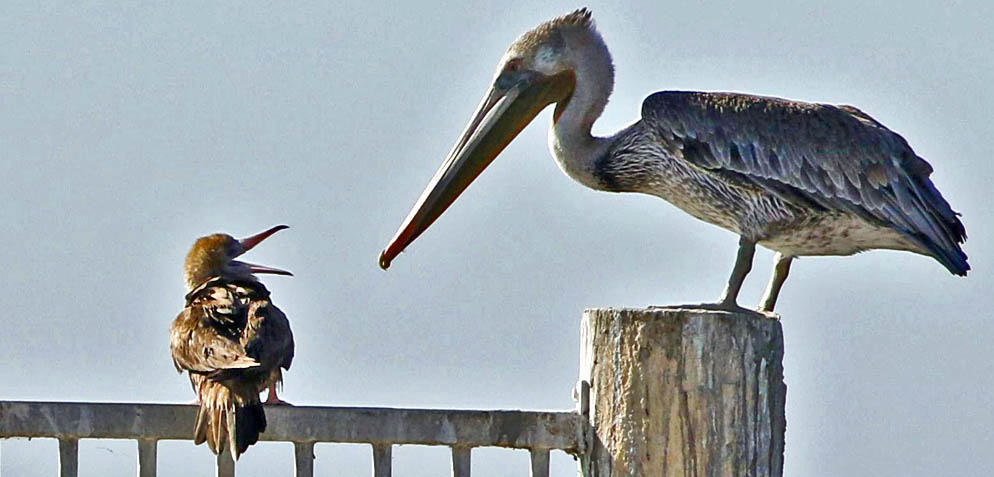
 The
return of the Masked Booby to its roost on 18 Oct coincided with "day
1" of the 4th annual 2018 Monterey Audubon "Pt. Pinos seawatch,
"featuring the return of Karl Bardon (from MN) for his second year as
the professional seawatcher. Here Karl, near left, scopes the booby
next to (L to R) Fred Hochstaedter, Mark Kudrav, Todd Wills, and
Michael Rieser (photo © D. Roberson). This year's seawatch runs
from 18 Oct–15 Dec, which is two weeks longer than the preceding three
efforts over the period 1 Nov-15 Dec.
The
return of the Masked Booby to its roost on 18 Oct coincided with "day
1" of the 4th annual 2018 Monterey Audubon "Pt. Pinos seawatch,
"featuring the return of Karl Bardon (from MN) for his second year as
the professional seawatcher. Here Karl, near left, scopes the booby
next to (L to R) Fred Hochstaedter, Mark Kudrav, Todd Wills, and
Michael Rieser (photo © D. Roberson). This year's seawatch runs
from 18 Oct–15 Dec, which is two weeks longer than the preceding three
efforts over the period 1 Nov-15 Dec. 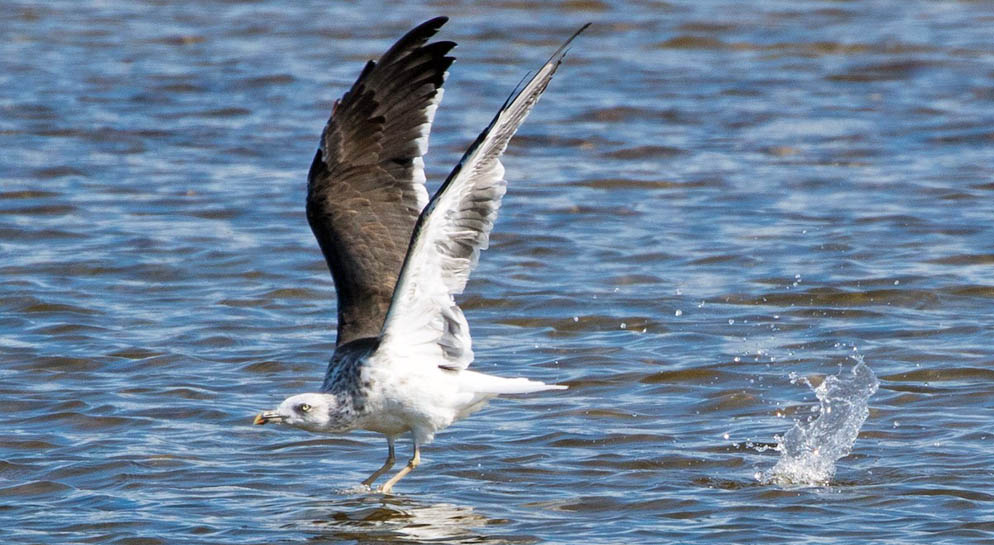



 The
first 3 records from MTY were reported Nov 2017-Jan 2018 but then there
were none for months; it seems apparent that these first released or
escaped birds did not survive. This fall, however, there are 4 records
around the Peninsula involving multiple birds in small flocks of up to
6-8 individuals. Laguna Grande Park and the Frog Pond Preserve had
small flocks in reedbeds. These might be birds from an expanding
population elsewhere in the State, but these sites are also the most
logical spots for people to release non-natives. Non-native turtles and
fish are known commonly from Laguna Grande and Roberts Lake; I
personally talked to someone releasing their large pet goldfish because
they had to move and felt these ponds would be places their pet might
survive. Munias breed easily in captivity, and often breed in our
autumn, so it is a logical time for pet-owners to release the whole
family. So far, none of these groups has been seen in any week
following a report, which might suggest the birds are not surviving. We
just don't know the true facts, and don't have enough data to determine
their status.
The
first 3 records from MTY were reported Nov 2017-Jan 2018 but then there
were none for months; it seems apparent that these first released or
escaped birds did not survive. This fall, however, there are 4 records
around the Peninsula involving multiple birds in small flocks of up to
6-8 individuals. Laguna Grande Park and the Frog Pond Preserve had
small flocks in reedbeds. These might be birds from an expanding
population elsewhere in the State, but these sites are also the most
logical spots for people to release non-natives. Non-native turtles and
fish are known commonly from Laguna Grande and Roberts Lake; I
personally talked to someone releasing their large pet goldfish because
they had to move and felt these ponds would be places their pet might
survive. Munias breed easily in captivity, and often breed in our
autumn, so it is a logical time for pet-owners to release the whole
family. So far, none of these groups has been seen in any week
following a report, which might suggest the birds are not surviving. We
just don't know the true facts, and don't have enough data to determine
their status.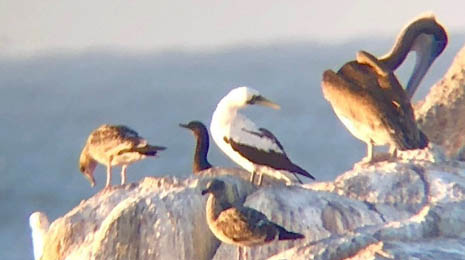

 Incredible eastern vagrants!
The fall of 2018 also sparkled as orchestrating one of the most
dazzling displays of colorful eastern North American vagrants in recent
history, particularly vireos and warblers. Probably the most unexpected
was the least pretentious: this Bell's Vireo, from one of the eastern populations (i.e., subspecies bellii or medius),
at Pt. Pinos from 14-17 Oct (photo right 16 Oct © D. Roberson).
Found by visiting bird John Mendoza of San Luis Obispo County, the very
active small passerine focused on coastal dune scrub and an occasional
adjacent cypresses during it stay, often at off-limits areas of the
Pacific Grove golf course at the Point.
Incredible eastern vagrants!
The fall of 2018 also sparkled as orchestrating one of the most
dazzling displays of colorful eastern North American vagrants in recent
history, particularly vireos and warblers. Probably the most unexpected
was the least pretentious: this Bell's Vireo, from one of the eastern populations (i.e., subspecies bellii or medius),
at Pt. Pinos from 14-17 Oct (photo right 16 Oct © D. Roberson).
Found by visiting bird John Mendoza of San Luis Obispo County, the very
active small passerine focused on coastal dune scrub and an occasional
adjacent cypresses during it stay, often at off-limits areas of the
Pacific Grove golf course at the Point.  On 11-12 Oct there was a hatch-year Yellow-green Vireo
at Laguna Grande Park, found by Paul Fenwick. Note the dark eye and
crisp plumage (photo left © Blake T. Matheson). A red-eyed adult
was in Pacific Grove earlier this fall; see photo on
On 11-12 Oct there was a hatch-year Yellow-green Vireo
at Laguna Grande Park, found by Paul Fenwick. Note the dark eye and
crisp plumage (photo left © Blake T. Matheson). A red-eyed adult
was in Pacific Grove earlier this fall; see photo on 
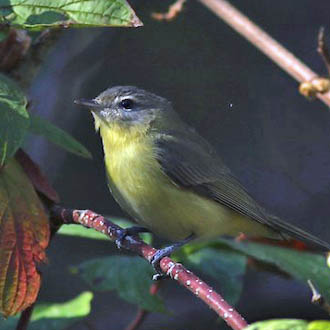

 Eastern
warblers made so many appearances in Sep–Oct that old timer's recalled
the "good old days" from the 1970s-1980s. What was particularly
interesting were comparative number among them. Usually routine
vagrants such as Northern Waterthrush, American Redstart, or Blackpoll
and Palm Warblers were found in average to below-average numbers while
Tennessee and Chestnut-sided Warblers made strong showings. What we'll
emphasize here are usually very rare warblers that delighted us by occurring in record numbers.
Eastern
warblers made so many appearances in Sep–Oct that old timer's recalled
the "good old days" from the 1970s-1980s. What was particularly
interesting were comparative number among them. Usually routine
vagrants such as Northern Waterthrush, American Redstart, or Blackpoll
and Palm Warblers were found in average to below-average numbers while
Tennessee and Chestnut-sided Warblers made strong showings. What we'll
emphasize here are usually very rare warblers that delighted us by occurring in record numbers. 

 Blackburnian Warbler,
always a rarity, has had "bad" years (when there are none) and "good"
years (e.g., 3 in autumns of 1985 & 1999) but never before have
there been as many as this fall, when six were located:
Blackburnian Warbler,
always a rarity, has had "bad" years (when there are none) and "good"
years (e.g., 3 in autumns of 1985 & 1999) but never before have
there been as many as this fall, when six were located:  Two
excellent fall vagrants got away without photos: a Least Flycatcher at
Carmel R. mouth on 3 Oct (Brian L. Sullivan) and a Common Ground-Dove
at Andrew Molera SP on 14 Oct (Blake T. Matheson).
Two
excellent fall vagrants got away without photos: a Least Flycatcher at
Carmel R. mouth on 3 Oct (Brian L. Sullivan) and a Common Ground-Dove
at Andrew Molera SP on 14 Oct (Blake T. Matheson).